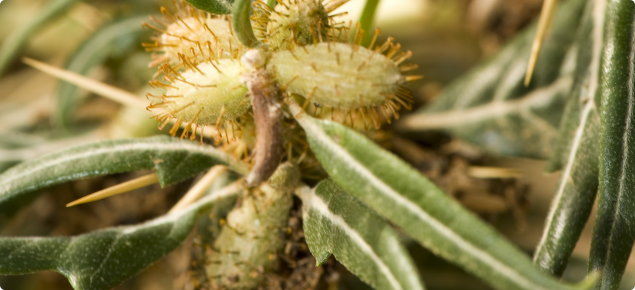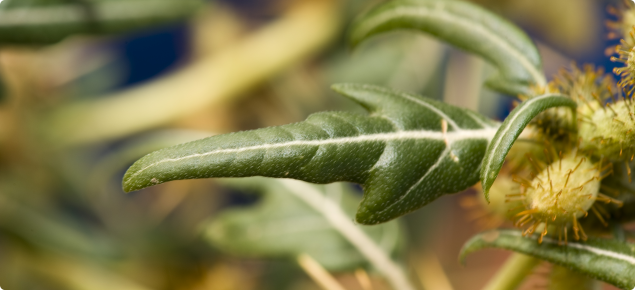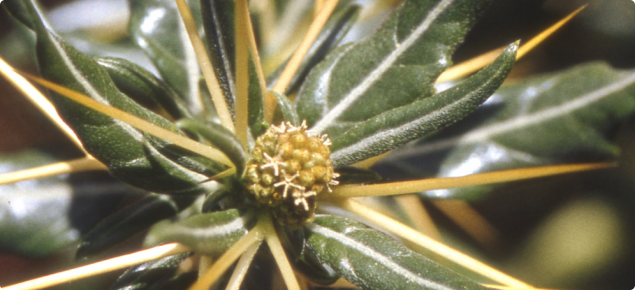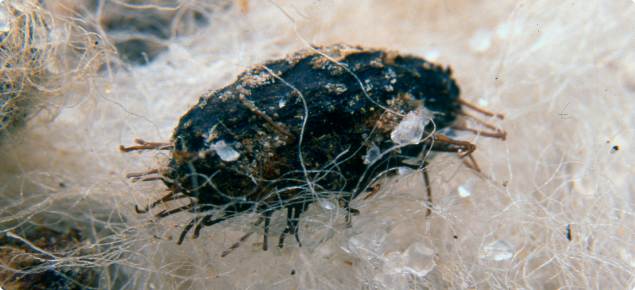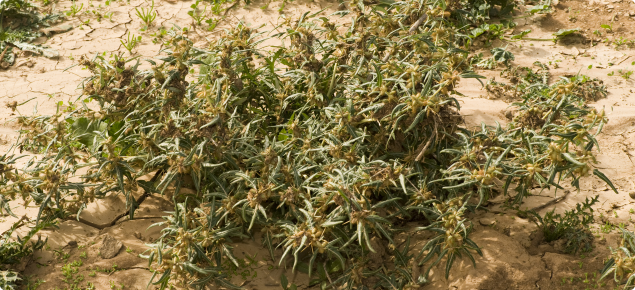Form: shrub – annual
Status: present in WA
Bathurst burr is a summer growing annual shrubby plant originating in South America. In south-western Australia, some mature plants survive well into winter, with the result that burrs may be found for most of the year. The weed spreads entirely by burrs that are usually carried by people or animals, attached to clothes, fur or other fibre by their hooked spines. They may also be dispersed by water or as a contaminant in seeds and hay.
Appearance
Bathurst burr is an erect, much-branched, bushy plant. It usually grows about 45 centimetres high but may reach 1.2 metres. It is best recognised by the presence of three-pronged straw-coloured spines set in the angle between leaf stalk and stem. These spines are up to 25 millimetres long.
Leaves: arranged alternately on the stem. They are thick in texture with three lobes, a large central lobe and two smaller side lobes. The upper surface is dark green with prominent veins, while the lower surface is pale with downy hairs. The stem is hairless.
Flowers: Bathurst burr flowers are small and inconspicuous. They are greenish white and set in the angle of the leaves. Those near the top of the stem are mostly male while female flowers form further down. The plant flowers from January until autumn, producing up to 150 burrs per plant.
Seeds: egg-shaped burrs about 10 millimetres long are produced by the female flowers. These are covered with numerous hooked spines. Each burr contains two brown, flattened seed about 9nine millimetres long, one of which is capable of immediate germination, but the second may stay dormant in the soil for several years. Dormancy depends on the permeability of the seed coat. This is broken down by high temperatures. Germination may also be controlled by day-length and daytime temperatures. The result is a staggered germination which makes seedlings difficult to control and allows the plant to exploit the variable environmental conditions under which it grows.
Online weed identification training
Login or set up a new account on DPIRDs online training site to access:
- a training course on how to identify Bathurst burr and report it.
- training material that you can use to teach community groups how to identify Bathurst burr.
Agricultural and economic impact
Bathurst burr is mainly a pasture and rangeland weed. However, it is also found in summer growing crops such as soya bean and maize. It can be a seed and hay contaminant.
Bathurst burr seedlings are poisonous, especially the cotyledons (seed leaves). Seedlings are quite palatable, however older plants are not eaten.
Burrs contaminate wool, reducing value of fleeces and causing problems for shearers. Bathurst burr is toxic to livestock, particularly the seeds and seedlings. Seedlings are palatable but mature plants are rarely eaten.
Declared pest category
The Western Australian Organism List (WAOL) contains information on the area(s) in which this pest is declared and the control and keeping categories to which it has been assigned in Western Australia (WA). Seach for Bathurst burr in the WAOL using the scientific name Xanthium spinosum.
Requirements for land owners/occupiers and other persons
Requirements for land owners/occupiers and other persons if this pest is found can be sourced through the declared plant requirements link.
Search > detect > report
| MyPestGuide™ Reporter | Pest and Disease Information Service (PaDIS) |
Detectability: medium difficulty to find. Bathurst burr plants have distinctive straw-coloured three-pronged spines and leaves which are dark green on the upper surface and white below. Mature plants have burrs covered with small hooked spines. The only other plant in WA with similar burrs is Noogoora burr which is also a declared plant and rarely found in the southwest land division.
Who is likely to find it: the sheep industry, as the burrs contaminate wool and importers or purchasers of products that burrs stick to or contaminate.
When to find it: Bathurst burr plants are most likely to be found in summer and autumn. Burrs could be found at any time.
Where to find it: burrs could be found on sheep/wool coming from the Goldfields where Bathurst burr is well established, as contaminants of imported livestock fodder and birdseed, and occasionally as contaminants of other imported products, for example, woven into floor mats or attached to fabrics or packaging. In the area known to have Bathurst burr (Mingenew) search for seedlings four weeks after heavy summer rain, for example, after a summer storm has reached the northern wheatbelt.
Control method
Control methods for this declared plant can be found through the Bathurst burr control link.

